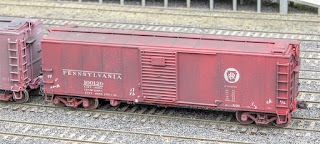 |
| Santa Fe Bx-12 rebuild photographed at Richmond, California in June, 1969. Jack Burgess photo |
Between 1941 and 1944, the Santa Fe rebuilt the vast majority of the Bx-11 and Bx-12 box cars. Initially, the program involved raising the roof by eight inches through the use of sheet steel "inserts" between the original tops of the sides and the eaves of the new roofs, as well as sheet steel "extensions" on the ends. At this time, the roofs were also replaced with Murphy rectangular panel roofs. The initial rebuilding was entirely Bx-11s, except for 51 Bx-12s. The resulting cars had an inside height of 10'0" and a cubic capacity of 3,712 feet, the same as the 1937 AAR box car.
In 1943, the program was altered to achieve an inside height of 10'6" and an increased cubic capacity of 3,898 feet. This necessitated adding five small pressed steel sections to support the side extensions. On the ends, instead of sheet steel, a section with a single Dreadnaught corrugation was added at the upper portion of the end.
In 1945, all of the taller 10'6" inside height rebuilds were renumbered into the 210000-211049 and 211051-214549 series. The maximum number of cars in these two combined series was in 1951, 952 and 3,213 cars, respectively. This put the number of tall rebuilds at approximately 4,200. ATSF 211050 was a lone plywood rebuild.
There are additional details about these cars beyond what is presented here. For more information, consult, "Santa Fe Extended-Height Box Cars," authored by Richard Hendrickson (Railmodel Journal, May 1995, pp. 45-47) and Santa Fe Boxcars 1869-1953 (Santa Fe Railway Rolling Stock Reference Series -- Volume Four, currently out of print), John C. Dobyne III from the SFRH&MS.
Westerfield offers excellent kits for the entire family of Bx-11/-12/-13, including the extended height rebuilds.
 |
This "portrait" of the end of ATSF 212368 illustrates the extra Dreadnaught corrugation in the extender panel at the top of the end. Jack Burgess photo.
|














